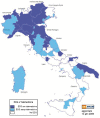ANMCO/SIT Consensus Document: telemedicine for cardiovascular emergency networks
- PMID: 28751844
- PMCID: PMC5520753
- DOI: 10.1093/eurheartj/sux028
ANMCO/SIT Consensus Document: telemedicine for cardiovascular emergency networks
Abstract
Telemedicine has deeply innovated the field of emergency cardiology, particularly the treatment of acute myocardial infarction. The ability to record an ECG in the early prehospital phase, thus avoiding any delay in diagnosing myocardial infarction with direct transfer to the cath-lab for primary angioplasty, has proven to significantly reduce treatment times and mortality. This consensus document aims to analyse the available evidence and organizational models based on a support by telemedicine, focusing on technical requirements, education, and legal aspects.
Keywords: Acute coronary syndrome; Acute myocardial infarction; Hub & spoke networks; STEMI; Telecardiology; Telemedicine; Unstable angina.
Figures




References
-
- www.salute.gov.it/imgs/c_17_pubblicazioni_2129_allegato.pdf (1 November 2015).
-
- Rasmussen MB, Frost L, Stengaard C, Brorholt-Petersen JU, Dodt KK, Søndergaard HM, Terkelsen CJ.. Diagnostic performance and system delay using telemedicine for prehospital diagnosis in triaging and treatment of STEMI. Heart 2014;100:711–715. - PubMed
-
- Mortara A, Oliva F,, Di Lenarda A.. Prospettive della telemedicina e del monitoraggio mediante dispositivi nel paziente con scompenso cardiaco cronico: luci e ombre. G Ital Cardiol 2010;11(5 Suppl 2):33S–37S. - PubMed
-
- Slotwiner D, Varma N, Akar JG, Annas G, Beardsall M, Fogel RI, Galizio NO, Glotzer TV, Leahy RA, Love CJ, McLean RC, Mittal S, Morichelli L, Patton KK, Raitt MH, Ricci RP, Rickard J, Schoenfeld MH, Serwer GA, Shea J, Varosy P, Verma A, Yu CM.. HRS Expert Consensus Statement on remote interrogation and monitoring for cardiovascular implantable electronic devices. Heart Rhythm 2015;12:e69–e100. - PubMed
-
- Kurek A, Tajstra M, Gadula-Gacek E, Buchta P, Skrzypek M, Pyka L, Wasiak M, Swietlinska M, Hawranek M, Polonski L, Gasior M, Kosiuk J.. Impact of remote monitoring on long-term prognosis in heart failure patients in a real-world cohort: results from all-comers COMMIT-HF Trial. J Cardiovasc Electrophysiol 2017; doi: 10.1111/jce.13174. - PubMed
LinkOut - more resources
Full Text Sources
Other Literature Sources
Miscellaneous
